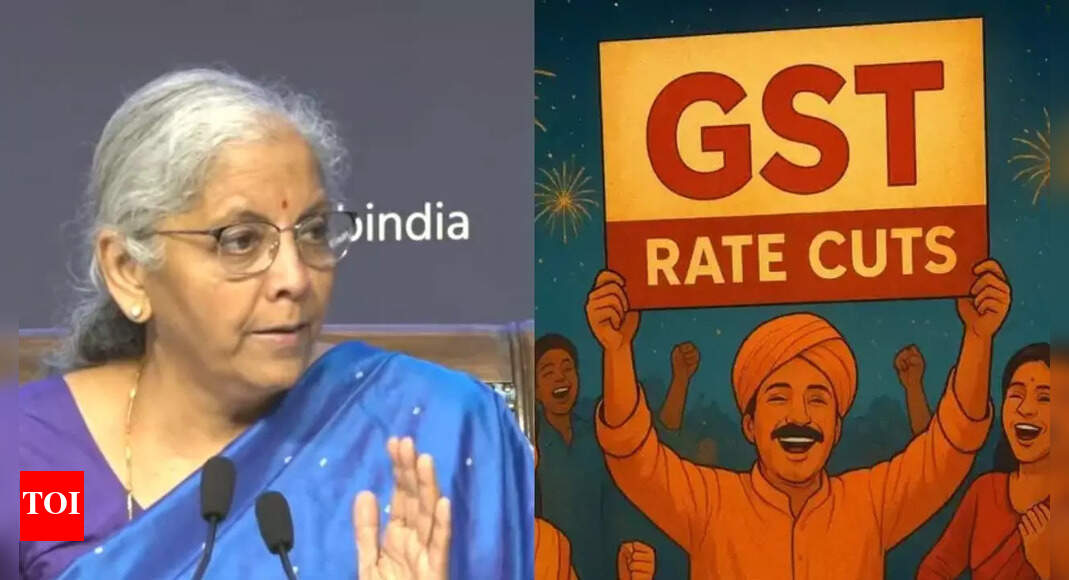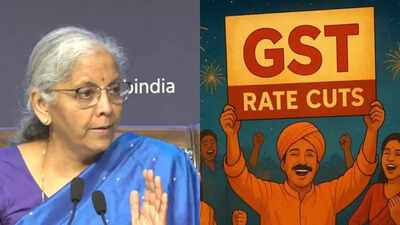Finance Minister Nirmala Sitharaman on Wednesday announced major Goods and Services Tax (GST) rate cuts, saying that with the two-tier tax rate system approved, the common man will benefit greatly. The GST Council approved the two-tier rate structure of 5% and 18%. The GST rate rationalisation will be implemented from September 22, according to a PTI report.“For common man and middle class items, there is a complete reduction from 18% and 12 to 5%. Items such as hair oil, toilet, soap bars, soap bars, shampoos, toothbrushes, toothpaste, bicycles, tableware, kitchenware and other household articles are now at 5%,” FM Sitharaman said. “UHT milk, paneer, all the Indian breads will see nil rate,” she added.Also read | GST rate cuts bonanza! What is cheaper and dearer? Check full list of items in 0%, 5%, 18% & 40% slabsThe 56th Goods and Services Tax (GST) Council meeting commenced on Wednesday to review potential rate reductions and category adjustments for numerous items under the indirect taxation system. The extensive 56th GST Council meeting, spanning 10.5 hours, provided a platform for the Centre and states to deliberate and discuss crucial tax proposals.The GST Council endorsed a transition from the existing four-tier GST framework (5, 12, 18 and 28 per cent) to a simplified two-rate structure of 5 and 18 per cent. Additionally, certain items like high-end vehicles, tobacco and cigarettes will attract a special 40 per cent rate.The revised rates will come into effect from September 22, coinciding with Navratri, except for gutkha, tobacco and tobacco products and cigarettes.Essential food items will remain tax-free, whilst various everyday food products and beverages will likely see reduced rates from 18 per cent to 5 per cent. This includes butter, ghee, dry nuts, condensed milk, sausages, meat, sugar boiled confectionery, jam, fruit jellies, tender coconut water, namkeen, 20-litre packaged drinking water, fruit pulp, juice, milk-based beverages, ice cream, pastry, biscuits, corn flakes, cereals and sugar confectionery.The tax rate for all varieties of chapati and paratha will be reduced from the current 5 per cent to nil.The modifications to the GST structure are crucial for boosting domestic consumption and helping businesses counter the impact of the United States’ 50% import duty on Indian products.Also read | GST reforms: 0% GST on individual health and life insurance; reduced from 18%
GST rate cuts: Key Highlights
- GST exemption for all individual life insurance policies, including term life, ULIP, endowment policies, and their reinsurance to enhance accessibility and coverage for the general public.
- Complete GST exemption for individual health insurance policies, encompassing family floater and senior citizen policies, along with their reinsurance to increase affordability and coverage.
- Current 4-tier tax structure into a ‘Simple Tax’ system with two rates: 18% Standard Rate and 5% Merit Rate, plus a 40% special rate for select items.
- GST reduction to 5% for everyday items from current 18% or 12%, including toiletries, household goods, bicycles, and kitchenware.
- Zero GST on UHT milk, packaged chena, paneer, and Indian breads (Chapati, roti, paratha, parotta).
- Lower GST to 5% from 12% or 18% on packaged foods including namkeens, Bhujia, sauces, noodles, chocolates, preserved meats, and dairy products.
- GST reduction from 28% to 18% proposed for appliances, including air conditioners, 32-inch TVs, dishwashers, and vehicles under 350cc.
- GST decreases to 5% from 12% for agricultural machinery, including tractors, harvesting equipment, and farming tools.
- Reduction to 5% GST for labour-intensive products like handicrafts, stone blocks, and leather goods.
- GST reductions for cement (28% to 18%), medicines (varying reductions including complete exemption for lifesaving drugs), medical equipment, automotive sector, textiles, fertilisers, renewable energy devices, hospitality services, and wellness services.
PM Narendra Modi in his Independence Day address had announced the upcoming GST reforms and rate cuts, Finance Minister Nirmala Sitharaman led these deliberations.The rationalisation of rates would entail a financial impact of Rs 48,000 crore, which would be “fiscally sustainable for Centre and state”, as confirmed by Revenue Secretary Arvind Shrivastava during a press briefing.He emphasised that revenue implications are variable figures that fluctuate based on consumption patterns. “Rate rationalisation results in buoyancy. We also expect compliance to improve”.After the GST Council meeting, Bihar’s Deputy Chief Minister Samrat Choudhary confirmed unanimous support from all states regarding rate rationalisation, emphasising the collective nature of the decision. Also Read | GST rate cuts from September 22! All you need to know about new tax rates for items – 75 FAQs answered




